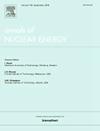Power distribution bias from equilibrium xenon effects when insufficient neutron histories per cycle are used in Monte Carlo simulation of CANDU6
IF 1.9
3区 工程技术
Q1 NUCLEAR SCIENCE & TECHNOLOGY
引用次数: 0
Abstract
This study examines the impact of insufficient neutron histories per cycle (N) on power distribution accuracy in Monte Carlo (MC) simulations of CANDU reactors when using equilibrium-xenon algorithms. We demonstrate that using an insufficient N with equilibrium xenon introduces significant bias into the power distribution. The observed bias is systematic with a strong flattening affect where power is suppressed in high-power bundles and increased in low-power bundles by up to several percent beyond the real physical flattening effect of xenon on the three-dimensional power distribution. At least to N must be used for criticality simulation with the 1/8th symmetric CANDU6 model studied to suppress the spatial power tilts and eliminate the bias. This recommended N is orders of magnitude larger than N used in previous full-core Monte Carlo simulations of CANDU reactors. A preliminary analysis of the CANDU bundle power tally variances shows there is an underestimation of the real variance by approximately a factor of two.
求助全文
约1分钟内获得全文
求助全文
来源期刊

Annals of Nuclear Energy
工程技术-核科学技术
CiteScore
4.30
自引率
21.10%
发文量
632
审稿时长
7.3 months
期刊介绍:
Annals of Nuclear Energy provides an international medium for the communication of original research, ideas and developments in all areas of the field of nuclear energy science and technology. Its scope embraces nuclear fuel reserves, fuel cycles and cost, materials, processing, system and component technology (fission only), design and optimization, direct conversion of nuclear energy sources, environmental control, reactor physics, heat transfer and fluid dynamics, structural analysis, fuel management, future developments, nuclear fuel and safety, nuclear aerosol, neutron physics, computer technology (both software and hardware), risk assessment, radioactive waste disposal and reactor thermal hydraulics. Papers submitted to Annals need to demonstrate a clear link to nuclear power generation/nuclear engineering. Papers which deal with pure nuclear physics, pure health physics, imaging, or attenuation and shielding properties of concretes and various geological materials are not within the scope of the journal. Also, papers that deal with policy or economics are not within the scope of the journal.
 求助内容:
求助内容: 应助结果提醒方式:
应助结果提醒方式:


